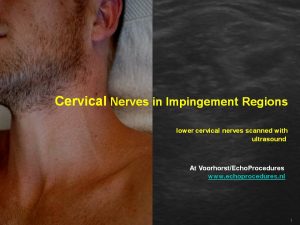Cervical Nerves in Impingement Regions, anatomy scanned with Ultrasound
Foreword: Cervical Nerves in Impingement Regions PDF: cervicaal A

Physiotherapists and ultrasound researchers do not often examine the cervical region with ultrasound. However, if the cervical anatomy under the echo probe was still difficult to interpret a few years ago, the current generation of ultrasound equipment has changed this. The regional anatomy is extremely complex and sometimes confusing, but with regular scanning it is possible to develop your skills and make statements about the continuity of nerve roots and about impingement problems such as those played by thoracic outlet syndrome, the quadrilateral axillary syndrome, n. suprascapularis compression and compression in the spinoglenoid notch.
The condition is that we first gather knowledge about the nerves in the neck, the course of the brachial plexus around the shoulder and in the upper arm. In addition, the relationship between the plexus and the most important landmarks requires your special attention. These are the transverse protrusions of the vertebrae, the arteries and veins.
By immersing ourselves in the ultrasound of various regions such as the neck and the groin, we more or less go beyond the more frequently walked paths of shoulder and knee examination. My experience is that increasing knowledge of ‘alternative regions’ benefits ultrasound research in a general sense.
To gain knowledge about the cervical structures in combination with ultrasound, you must (again) consult the anatomy and read what has been published in scientific literature in this area. With this presentation, this preliminary work has already been done with which this region has become more accessible for the interested physiotherapist, ultrasound or health care professional.
At Voorhorst